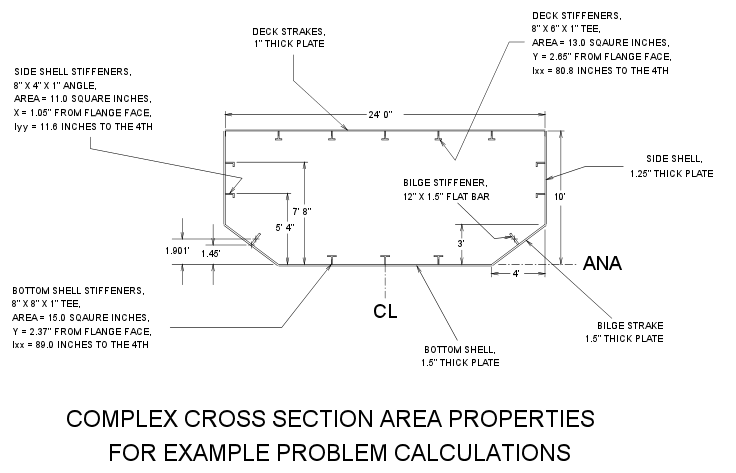Area Properties (including total area, area center
& moment of inertia) for Ship or Boat Cross
Section
or other Large Complex Cross Section (Metric
Units)
Description
Computes cross sectional area properties of a complex
framing member, like a ship or boat cross
section, made up of
a numerous components (Like a
tees, angles, and flat bars
that placed on
various pieces of
plate). Area properties from this sheet can be used
as a part of the process utilized to obtain
flexural stress, average shear stress and deflection.
The inputs may
seem a bit complicated at first. But they
are really easy to obtain and are clearly explained
within the template instructions.
To assist with this process, there is a small simple diagram located on
the spreadsheet itself, that shows the geometric characteristics that are
required as inputs.
This complex section spreadsheet is different in several
ways from the normal
framing section modulus spreadsheet. First it is assumed the
cross section here is expected to contain a whole lot more components.
Second, the input distances from assumed neutral axis is in "meters"
rather than "mm." Third, some of the outputs are in different units.
The output distance between the ANA and the NA is in "meters" instead of
"mm." The output moment of inertia is in units of "meters
squared x centimeters squared" instead of "centimeters to the fourth."
The output section modulus is in units of "centimeters squared x
meters" instead of "centimeters cubed." The units change was to keep
the output numbers smaller and thus more manageable. Traditional
ship design practice also follows this mixed units route for large cross
sections.
For each framing component of the section the user must
select one of two options. In Option One, which applies to flat bar
and plating sections, the spreadsheet will automatically calculate the
component's cross sectional area and moment of inertia. For Option
Two, component sectional properties are required from a geometric
properties table such as those contained in the A. I. S. C. Manual of
Steel Construction or equivalent for metric units. This option
applies to components like tees, angles, I beams, channels, round bar,
tubing, pipe, etc.
This spreadsheet is geared toward metric units of measure
commonly used in the Europe. For determining moment of inertia and
section modulus in English or Imperial units go the the
English units ship or complex section calculation spreadsheet.
For this spreadsheet to work all the components of the
section must be of the same material. For instance a section must be
made out of all steel or out of all aluminum. Another type of
spreadsheet is required for a mixed material section (or composite
section).
Electronic
Document Type: Microsoft Excel
spreadsheet
Cost:
$32.00 US funds
Number of
Pages: single sheet
Inputs:
-
overall
depth
of framing member (for all components combined)
-
location of
assumed neutral axis ANA (perpendicular to loading
direction)
-
For each Option One Component (flat bar or
plating
components) the following
are required: description, cross section
dimensions, distance to centroid from ANA,
radius of gyration for convenience the method
of obtaining this dimension is shown in a diagram on the spreadsheet.
The spreadsheet actually contains fifteen rows to accommodate fifteen
Option One components. With proper understanding the user may
add additional rows if necessary. Note that the example below
only shows 6 rows.
-
For each Option Two Component (tees, angle
irons, channels, i beams, tubing, round bars or similar
sections) the following
are required: description, cross sectional
area, distance to centroid (for
determining distance to ANA),
moment of inertia about own centroidal axis.
The last three datum are normally obtained from a tables, like those
contained in the A. I.
S. C. Manual of Steel Construction.
There are 20 rows to accommodate twenty Option Two members. An
experienced Excel user may add more rows when required. The
example below only contains 5 rows.
Outputs:
-
total
cross sectional area
-
distance from
cross sectional area centroid to the ANA
-
moment of
inertia of the complex cross section
-
section
modulus of the complex
cross section
Items Included with the Product:
A blank template for you to input data. -
A set of instructions on how to perform the
analysis.
-
A sample calculation already filled out. It
is recommended that each cell within the sample calculation be examined
to fully grasp the techniques involved.
-
A drawing of the sample cross section .
-
A sheet containing the products standard "Use Terms."
Suggested
Reading or References:
Terms:
Prior to purchase, read our
End User License Terms.
Important Notice to European Union Buyers:
Due to changes in international law, we
no longer accept purchases from any individuals located
within an EU country. However, businesses located
within the EU are allowed to make purchases, provided that they make
the VAT payments for any imported items purchased electronically.
These EU businesses must specify their VAT number in the memo
section on the Paypal payment pages. These changes are
effective as of July 1, 2008, and were modified for EU businesses on
April 9, 2010.
Download Now:
Click one of the following buttons to pay.
After payment you will be taken directly to the download page.
Minimum System Requirements: Windows 95/98/NT/2000/XP/Vista/Windows7
Customer Comments Regarding Similar Template:
Go to feedback page,
click here.
Sample:
A sample calculation and
cross section are shown below. Note that
the example calculations and figure are in English units, but the blank
template provided with this product in for metric units.


|




